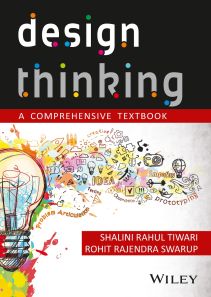Design Thinking: A Comprehensive Textbook
ISBN: 9789357468640
340 pages
Publication Year: 2024
For more information write to us at: acadmktg@wiley.com

Description
As an aspiring business leader, you are required to think critically and creatively to find and solve complex problems or address possibilists so as to foster sustainable business growth. Your ability to think analytically as well as outside the box and delve into the perspectives of your stakeholders, especially your customers, is paramount. This book will empower you to master such skills. This textbook gives you a toolkit to navigate the complex world using design thinking by offering simple techniques that you can use to identify challenges and then transform those challenges into opportunities. You will learn to put observation and empathy at the core of your decision-making, ideating, and prototyping competencies, and test your solutions with real users. The book is packed with real-life case studies to showcase the power of design thinking in identifying, articulating, and solving diverse challenges. The book is replete with in-class and field-based activities to help you sharpen your problem-solving and decision-making skills by challenging assumptions and designing meaningful solutions.
Foreword
Preface
Acknowledgments
About the Authors
How This Book Is Organized
How to Get the Most Out of This Book
Instructor Resources
1. What Is Design Thinking, Really?
Introduction
Welcome to the World of Design Thinking!
Perspectives on Design Thinking
Sensemaking and Problem-Solving Perspective of Design Thinking
Design Thinking and Management Education
Design Thinking in Tackling Management Challenges
Design Thinking in Organizations
Is Design Thinking an Art or Science?
Has Design Thinking Been Oversimplified?
Key Takeaways
Assignment Questions
Review Questions
Post-Class Activity
ANNEXURE 1
Range of Design Thinking Interventions for Management Programs
2. Setting the Stage for Design Thinking in Management Education
Introduction
Establishing the Context for Design Thinking Project
Design Thinking in a Nutshell
Traditional Problem-Solving and Design Thinking
Research and Planning for a DT Project
DT Journey Guidelines
What Constitutes DT Problems?
Principles of Design Thinking Relevant for Business Management
Key Takeaways
Assignment Questions
Review Questions
Post-Class Activity
3. Establishing the Design Thinking Essentials
Introduction
Ensuring the DT Mindset
Design Thinking Starts with a Beginner’s Mindset!
Role of Teams in Design Thinking—Assembling a Dream Team!
Effects of Design Thinking on Teams
Introducing the DT Process to Teams
DT Warm-up (Ice-breaking) Exercises
Debrief for the Instructors
Fun Quiz
Key Takeaways
Assignment Questions
Review Questions
Post-Class Activity
4. The DT Process—Understanding the Environment
Introduction
STEEP Analysis
When to Use a STEEP Analysis
Establishing Strategic Priorities
Activity System
Opportunity Framing
Key Takeaways
Assignment Questions
Review Questions
Post-Class Activity
5. Understanding the Stakeholders’ Perspective—Empathy
Introduction
Is Empathy the Same as Sympathy?
How to Use Empathy in Design Thinking
Mastering Empathy
Who Is an Extreme User?
Advantages of Using User Stories in Design Thinking
Emotional Response Cards (ERCs)
Empathy Mapping
Process of Building an Empathy Map
User Personas
Key Takeaways
Assignment Questions
Review Questions
Post-Class Activity
6. Defining the Point of View—Problem Articulation
Introduction
How Might We
Storytelling
What Makes a Good Story?
Using Storyboard to Create the Story
Requirement for a Storyboard
Developing the Storyboard
How to Create a Story Based on Information and Insights?
Context Mapping
Creating a Context Map
Defining Success
Key Takeaways
Assignment Questions
Review Questions
Post-Class Activity
7. Ideation
Introduction
Significance of the Ideation Stage
Ideation Techniques
Brainstorming
Worst Idea Technique
Brainwriting Technique
Questioning Assumptions Technique
Analogies Technique
SCAMPER Technique
BodyStorm Technique
6-5-3 Technique
Lotus Blossom Technique
Crazy 8 Technique
Evaluating the Ideas
Key Takeaways
Assignment Questions
Review Questions
Post-Class Activity
8. Creating the Prototype
Introduction
Types of Prototyping
Low-Fidelity Prototyping
Paper Prototyping
High-Fidelity Prototyping
Pointers for Effective Prototyping
In the Nutshell
Critical Experience Prototype (CEP) and Critical Function Prototype (CFP)
Dark Horse Prototype
Funky Prototype
Vision Prototype
Functional Prototype
Finished Prototype
Final Prototype
Exploration Map
Service Blueprint
Minimum Viable Product (MVP)
Benefits of the MVP Process
Testing Approaches for the MVP
Websites and Applications
Services
New Features
How Does This Differ from “Release Early, Release Often”?
Key Takeaways
Assignment Questions
Review Questions
Post-Class Activity
9. Testing
Introduction
Testing Phase
Why Is Testing Necessary?
Interesting Trivia
Tools for the Testing Phase
Testing Sheet
Feedback Capture Grid
Asking Powerful Questions in Experience Testing
Solution Interview
A/B Testing
Key Takeaways
Assignment Questions
Review Questions
Post-Class Activity
10. Reflection
Introduction
Tools Used in the Reflection Stage
I Like, I Wish, I Wonder (IL/IW/IW)
Retrospective Sailboat
Ask Each Other
Conclusion
Assignment Questions
Review Questions
Post-Class Activity
11. Execution
Introduction
Implementation Phase
Nature of the DT Solution
Tools for the Implementation of DT Solution
Creating a Pitch
Business Model Canvas and Lean Canvas
Scaling Up and Growth
Key Takeaways
Assignment Questions
Review Questions
Post-Class Activity
12. The Conclusion
The Journey So Far…
Design Thinking in the Digital World
Arenas Where Design Thinking Will Be a Game Changer
Careers in Design Thinking
Leading Design Thinking Experts
Conclusion
Key Takeaways
Assignment Questions
Review Questions
Post-Class Activity
A Ready Reckoner of Design Thinking Terms—Glossary
Additional Resources
Index

